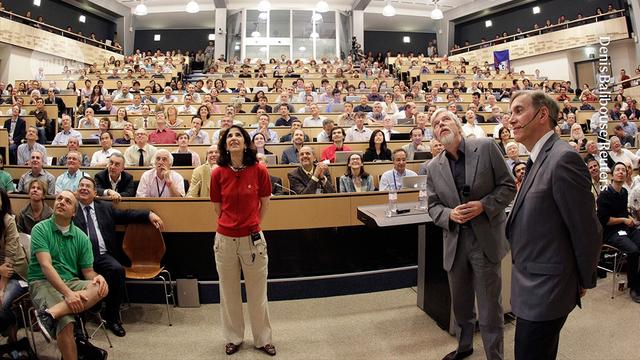The atom-smashing Large Hadron Collider’s successor will be 56 miles wide.
@PopularScience reports on plans for the Future Circular Collider: https://flip.it/aqT-_U

The atom-smashing Large Hadron Collider’s successor will be 56 miles wide.
@PopularScience reports on plans for the Future Circular Collider: https://flip.it/aqT-_U

CERN scientists find evidence of quantum entanglement in sheep
https://home.cern/news/news/physics/cern-scientists-find-evidence-quantum-entanglement-sheep
CERN scientists find evidence of quantum entanglement in sheep
https://home.cern/news/news/physics/cern-scientists-find-evidence-quantum-entanglement-sheep
#ycombinator #physics #CERN #Large_Hadron_Collider #LHC #high_energy_physics #particles #science
What CERN does next matters for science and for international cooperation
—Nature
「 It is unclear whether, or which, countries could step up to fill funding gaps. Germany — which already provides 20% of the lab’s budget — in particular, has already signalled that it won’t raise its contributions 」
https://www.nature.com/articles/d41586-025-00787-9

A new piece in the matter–antimatter puzzle
The LHCb experiment at CERN has revealed a fundamental asymmetry in the behaviour of particles called baryons
https://home.cern/news/press-release/physics/new-piece-matter-antimatter-puzzle
New #openaccess publication #SciPost #Physics #Codebases
Kolya: An open-source package for inclusive semileptonic B decays
Matteo Fael, Ilija S. Milutin, K. Keri Vos
Paper:
SciPost Phys. Codebases 55 (2025)
https://scipost.org/SciPostPhysCodeb.55
Kolya v1.0:
SciPost Phys. Codebases 55-r1.0 (2025)
https://scipost.org/SciPostPhysCodeb.55-r1.0
PSA to my fellow #nerds who like #programming in @ruby and/or #webprogramming who would also like to visit
CERN in
#geneva — the place where @timbl invented the
#web.
If you need a reason to visit #cern, maybe also for the #largehadroncollider, then this might be it.
https://ruby.social/@helvetic_ruby/114179005684458096
And keep in mind that @helvetic_ruby is switching places each year. So if you'd like to have this combo then 2025 is the year for you.
On March 12, 1989, Tim Berners-Lee submitted a proposal for an information management system to his boss at CERN. “Vague but exciting” was his feedback. The project later became the World Wide Web.
Thank you, Sir Tim Berners-Lee, for changing the world!
New #openaccess publication #SciPost #Physics
Normalizing flows for high-dimensional detector simulations
Florian Ernst, Luigi Favaro, Claudius Krause, Tilman Plehn, David Shih
SciPost Phys. 18, 081 (2025)
https://scipost.org/SciPostPhys.18.3.081
Pioneering #CERN scheme will pay publishers more if they hit #openscience targets
#Physics funder will provide financial incentives to encourage practices such as data sharing and transparent #peerreview.
Journals publish work from field openly and at no cost to authors, in exchange for bulk payments. Under initiative, CERN will pay more to publishers that adopt polices such as public or open peer review and linking research to data sets, and less to those that don't.
https://www.nature.com/articles/d41586-025-00183-3
Now @hharen promoted the upcoming edition of @helvetic_ruby in #Geneva
#Switzerland in may.
Feel free to ping me if you want to meet there.
Oh, @realpawels talk at #rubycommunityconference reminds me of the upcoming edition of @helvetic_ruby since there will be a trip to #cern, the birthplace of the #web.
CERN has yet to produce images as compelling as those I can snag in the local car wash.
New #openaccess publication #SciPost #Physics
Measurement of exclusive J/ψ and ψ(2S) production at sqrt(s) = 13 TeV
LHCb Collaboration
SciPost Phys. 18, 071 (2025)
https://scipost.org/SciPostPhys.18.2.071
In early 2021 “MALT is in pilot mode
Next year will be confirming alternatives and preparing migrations”: https://indico.cern.ch/event/876772/contributions/4175426/attachments/2170192/3664010/20210113-MALT-Project-Update.pdf
In mid 2021 MALT results were still being assessed. As example 80% reduction in the number of active Microsoft Project users: https://indico.cern.ch/event/1030590/contributions/4327395/attachments/2264812/3845200/PMMU-20210615.pdf
Then #FOSS at #CERN website was scrubbed: https://foss.web.cern.ch/foss/
The Compute Group in #CERN IT is hiring a #Kubernetes engineer! Join us and help shaping the cloud native infrastructure at CERN, the largest particle physics laboratory in the world! https://jobs.smartrecruiters.com/CERN/744000042612585-kubernetes-service-engineer-it-cd-pi-2025-18-ld- #K8s #OpenStack
Tim Berners-Lee created the first website info.cern.ch at CERN in 1990. It was a simple page explaining what the World Wide Web was and how to set up a web server. Along with it, he also built WorldWideWeb (renamed Nexus), the first-ever web browser, which only ran on NeXT computers. This is not to be confused with the "World Wide Web" aka: the internet, which seems to be a common mistake. Unfortunately the browser is no longer available that I have found.
The second browser? That was Line Mode Browser, released in 1992. Unlike WorldWideWeb, it could run on multiple operating systems and was the first browser many people used to access the web. You can still get the source code for Line Mode Browser, or launch the simulator line-mode.cern.ch
The internet was never the same again.
Why we still need a CERN for climate change
https://physicsworld.com/a/why-we-still-need-a-cern-for-climate-change/
Tim Palmer says that we must pool our resources to produce high-resolution climate models that societies can use, before it is too late
glané sur le net
Un grand projet inutile et imposé au CERN: Le Centre européen de recherche nucléaire (CERN) projette de construire le plus grand et le plus puissant accélérateur de particules au monde. Une nécessité scientifique pour une poignée de décideurs, une aberration écologique et financière pour ses opposants, parmi lesquels des chercheurs. La (…)
-- de plus en plus de riverains, d'associations… https://sciences-critiques.fr/un-grand-projet-inutile-et-impose-au-cern/?utm_source=dlvr.it&utm_medium=mastodon #CERN #Sciences #Recherche #Écologie #AccélérateurDeParticules